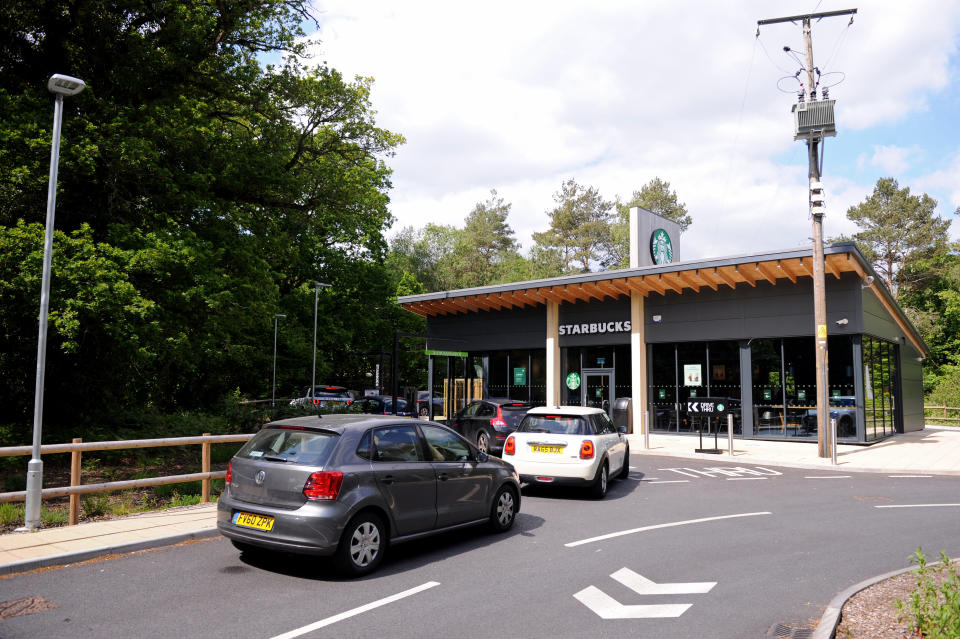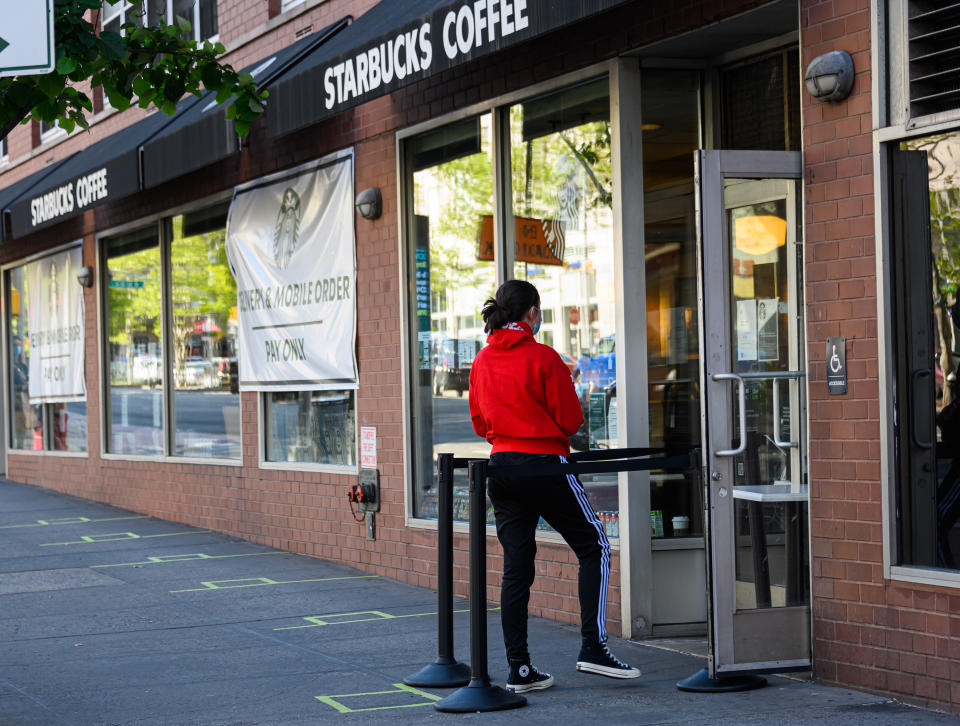Starbucks CEO: Customers seek a haven of the 'safe, familiar, and convenient' during coronavirus
Starbucks (SBUX) CEO Kevin Johnson sees the disruption from the COVID-19 pandemic reshaping consumer behavior, and the tech-savvy executive is already pivoting the coffee chain for that future.
The coronavirus outbreak has buffeted Corporate America’s biggest giants — including Starbucks. The coffee giant saw its second quarter revenue drop 38% year-over-year as the pandemic forced store closures in its biggest markets, while lockdowns kept customers out of stores.
However, Johnson told Yahoo Finance in a wide-ranging interview that while the crisis “has disrupted all of our worlds, personally and professionally... it really is reshaping consumer behavior in some very significant ways.”
In theory, at least some of the new reality will revert to normal when a COVID-19 vaccine becomes widely available. However, “for the near future, and I think for the next decade, we're going to see consumer behavior seek out things that are familiar, things that are convenient," this week on the heels of its fiscal third-quarter earnings results.
To be sure, Starbucks still sees a future where customers will seek "that third place connection," especially as more therapeutics for the virus are made available. With more than 32,000 stores worldwide, Starbucks has always promoted itself as a destination — or a "third place" between work and home.
But at least for now — with more of its clientele working from home and scores more unemployed — customers that seek those "safe, familiar, and convenient" experiences will bode well for the coffee giant, Johnson said. Those customers can choose from options like drive-thru, mobile order for pickup, contactless pickup, and the upcoming curbside pickup offering.

Meet the walk-thru
In mid-March, as the coronavirus took its grip, Starbucks suspended café seating and moved to a "to go" format in the U.S. Shortly thereafter, the chain pivoted to drive-thru and delivery only to adhere to social distancing rules.
Beginning in May, Starbucks began reopening its stores for mobile orders, entryway pickup, and in-store to-go orders. As of the end of June, 96% of Starbucks' U.S. stores were open, up from 44% at the start of the quarter. What's more, approximately 90% of the sales volume came either from the drive-thru or mobile order-and-pay during the period.
Recognizing this opportunity, Johnson recently detailed plans to transform Starbucks' stores by adding more drive-thrus and Starbucks Pickup stores — accelerating the coffee giant's initial transformation timeline of three to five years. The CEO stated that “urban core markets” are a big focus, using “walk-thru” options.
With in-store access closed due to the pandemic, cars would oftentimes line up out into the street, waiting to place an order at drive-thrus. To increase the throughput, Johnson said the company will deploy handheld point-of-sale devices for employees to take orders by walking through the line of cars.
Formally called a Starbucks Pickup store, walk-thrus leave a much smaller footprint that requires the company to deploy less capital, but still offers the same beverages and food items found in a traditional store.
What that means for customers is using a mobile app to grab and go, Johnson explained. "And so we're going to blend these Starbucks Pickup stores with traditional Starbucks stores so that we can meet the very need states of consumers," he added.
The company plans to roll out more than 50 Pickup stores in the next 12 to 18 months, and several hundred over the next three to five years.
Embracing human-centered design

Johnson — who assumed the top job in 2017 — hails from a tech background, having previously served as CEO of Juniper Networks (JNPR) and a top executive at Microsoft (MSFT).
One of the approaches Johnson has deployed at Starbucks is embracing human-centered design. It's a problem-solving methodology that puts the customer and employee experience and interaction — including the physical and digital environment — at every step of the process.
Human-centered design is "more important today than ever," Johnson said.
"Because when you have a disruption like this, that is going to is going to reshape consumer behavior, your ability to really focus on human-centered design, understand that behavior, understand the reasons behind it is more important today than ever,” he added.
This approach has helped Starbucks come up with protocols and processes, from the safety procedures to the newest offering — curbside pickup.
"We're now launching curbside in 700 to 1,000 stores across the country. We've never had that before," Johnson said adding that a mask-less option is built into the app.
“You place your mobile order, and if you don't want to put your mask on and go in the store, you pull in the front curb, and you push a little button that says I'm here and friendly barista wearing green apron will run out and provide you your food and beverage,” the CEO added.
Throughout the pandemic, Starbucks has continued to innovate, with much of that coming from its Seattle-based Tryer Center, an innovation hub where employees can test and try beverages, prototype and build new equipment, and create processes that make the in-store experience more efficient for customers and partners.
"So we figured out how to with masks and socially distancing and all the things to have our innovators still be able to come in here to the building and create all the great things that serve our stores and serve our partners in the stores," Johnson added.
‘We know that masks work’

Before masks in public became commonplace in the U.S., Starbucks had some foresight into how the crisis would unfold domestically. The company first saw an impact on its business from COVID-19 in China, its second-largest market — when it was forced to shutter more than half of its stores in the mainland.
Presently, 99% of the China-based stores are open, with 90% operating under regular hours and more than 70% now featuring full seating. In the U.S. the coffee chain has gradually opened some stores for limited seating, expanding across 30% of its store footprint at the end of the quarter.
"We basically have taken those [China] protocols and woven them into the fabric of how we operate, and so we can adapt to whatever COVID-19 throws at us," Johnson said. Once curves flatten across the country, Starbucks can “slowly turn the dial up and open up more customer experiences." The company can also "turn back the dial" in other areas to help contain any resurgence.
When Starbucks reopened its stores in early May, it required all of its employees to wear facial coverings, something Johnson insisted was effective.
"And we know that masks work. We know that helps contain the spread of the virus,” the CEO said.
“So when we reopened stores, we required our partners to wear masks, and we respectfully requested that customers coming into our stores also wear masks, and many did," Johnson added.
A company that closely monitors data, Starbucks decided in early July to require all customers to wear masks, even in areas without a government mandate. Since it made the requirement, other major retailers, including Walmart, CVS, Target, and Best Buy have all followed.
"We knew this was inevitable that, as citizens, we have a responsibility to contribute in a positive way to containing mitigating the virus. And as a business, we also have a responsibility,” Johnson said.
He added that the policy ensures “a safe experience for our partners who are serving them, as well as the customers, other customers that come into the stores."
Julia La Roche is a Correspondent for Yahoo Finance. Follow her on Twitter.
